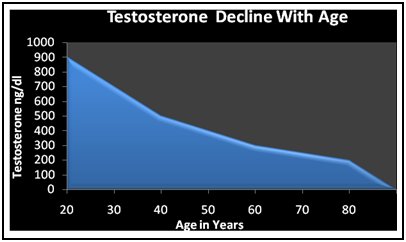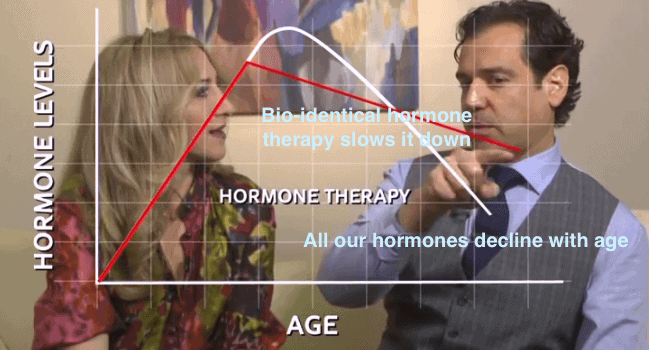How Russell Crowe’s Makeup Artist Got To Look Fabulous With Hormone Therapy For Anti-aging
What is hormone therapy for anti-aging? Should you care about it? Hormone expert Dr. Paziotopoulos explains things to host to WGN-TV host Jane Monzures. And then Russell Crowe’s makeup artist shares how she became “the hottest mother of four he’s ever seen!”
If you glanced over there at the sidebar you’d see a bunch of topics that I write about (“CATEGORIES”). Click on Hormone Optimization, and — insta presto — you get a deep dive into various hormone issues that are either now, or someday will be, the bane of your existence.
Rather than another complicated treatise on the subject, it’s time for a simpler approach, one more suited to people just beginning to wonder what hormone therapy for anti-aging purposes looks like. And for that I’m going to summarize a recent article and accompanying video that recently aired on WGN-TV.
This is a quick look at which hormones may need to be involved in an anti-aging regimen, how they’re administered, and how Russel Crowe’s make-up artist got to look so great thru hormone therapy for anti-aging purposes.
For those of you who want to jump right into the video, have at it:
Some highlights from Dr. Paziotopoulos:
- If you wait till your hormones get imbalanced, you’ve waited too long
- You notice the difference at 50, and by 60, bio-identical hormone therapy can yield profound benefits
- Women need testosterone too, and for many its too low
- Testosterone can be administered by a injected pellet, thyroid by mouth, progesterone by topical cream
Some highlights from actor Russel Crowe’s makeup artist:
- Began hormone therapy for crippling osteoarthritis that left her nearly bed-ridden and suicidal
- Saw results within two weeks
- The therapy dramatically improved her arthritis, her anxiety went away, skin glowed, energy returned
The doctor in the video is Alex Paziotopoulos, an expert in hormone therapy. He describes hormone therapy as basically the process of replacing the natural hormones in your body with bio-identical hormones.
According to Harvard Health Publication, bio-identical hormones are identical in molecular structure to the hormones we make in our bodies. They’re not found in this form in nature, but are made, or synthesized, from a plant chemical extracted from such plants as yams and soy. Bioidentical estrogens are 17 beta-estradiol, estrone, and estriol. (Estradiol is the form of estrogen that decreases at menopause.) Bioidentical progesterone is simply progesterone, which is micronized (finely ground) in the laboratory for better absorption in the body.
Our hormones have a profound affect on our bodies, and we have lots of them. There are hormones from your adrenal glands, like cortisol, to your thyroid gland, to your estrogens, your progesterone, your testosterone, your DHEA, and more.
Hormones can fluctuate because of aging, stress levels, lack of exercise, and diet. Although this up and down fluctuation can be influenced by various lifestyle behaviors, the general trend for hormones is down, no matter what you do behaviorally.
We get older, they get lower.
Note how fast human growth hormone drops after age 10!

Getting human growth hormone injections is expensive and controversial. What you could do to boost it — as high as 771% in any particular day — is do high intensity interval training: Boost Your Human Growth Hormone In 20 Minutes!
A woman’s drop in estrogen and progesterone, happily, doesn’t do a free fall by age 10, but the decline does kick in at about 35. I’m not expert, but I have read up a bit on this, and it seems one key consideration is to try to maintain the ratio of estrogen to progesterone that was maintained in a woman’s thirties. Apparently, it’s not only the overall decline in the amounts of these two hormones produced by a woman’s body, but the widening gap between them that contributes to weight gain, lethargy, moodiness, and other unpleasant things.
I write about some supplements you may consider in A Women’s Health Is In Her Own Hands. It would be smart to take this up with your doctor, however, before popping pills and rubbing on creams.
And, finally, the hormone you may have heard the most about when it comes to not having enough… testosterone. Yeah, Mister, step by step, yours is declining. I’m certainly not smirking — have had my own battles.
If you’re past 40 and feeling blue, unclear, libido-less, listless and sporting a paunch, read the two articles I present below this next graph.

You may read more about my experiments with boosting my testosterone in these articles:
- Boost Your Testosterone The Natural Way: Here’s How
- More Muscle, Testosterone and Calm With Ashwagandha
So, the point of all this hormone talk is that yours need to be as optimized as possible if you’re going to have a robust second half of life.
If you watched the video above, you heard Dr. Paziotopoulos say that natural hormone replacement helps combat many of the signs we generally associate with aging, but that it can also help reduce our chances for getting cancer and cardiovascular disease, and for bone and muscle loss.
The BIG caveat with hormone therapy for anti-aging, or any other reason, is that you really do need the guidance of a medical specialist. Hormones are delicate things and they are all interdependent, so we need to be careful about how supercharging one — say testosterone — is going to impact other hormones.
Despite what I just wrote, the truth is that I’m not taking my own advice!
I’ve been experimenting with boosting my testosterone, a hormone that always declines with age and, if too low, can have profound effects in a man. As mentioned — mood, zeal, self-confidence, lean body mass and sexuality are all influenced by testosterone.
And, to be frank, contrary to my own advice, I’m doing the testosterone dance without the guidance of an endocrinologist.
Now, as you know, we all have an unlimited capacity to rationalize anything, and what I tell myself about my testosterone experiment is that it’s safe, because I’m not taking anything synthesized by a pharmacy, am careful to cycle in and out of my supplementation, and take blood tests every six months to check my testosterone levels.
After having tried many different supplements, herbs and the like, I’ve pretty much settled on Mike Mahler’s Aggressive Strength Testosterone Booster and the Indian adaptogen, Ashwagandha.
These are my affiliate links for them:
Mahler’s formulation is special and proprietary. It includes both herbs to boost testosterone by supporting a man’s natural testosterone producing capability, and to reduce which can feminize a man.The Banyan brand for Ashwagandha is reputed to be of superior quality, but beyond that, I’m unaware of why it would be superior to any other organic Ashwagandha.
Right now, I’m taking 88 Herbs’ KSM-66 Ashwagandha. 88 Herbs is a new supplement company based in Canada. They’re committed to making supplements with novel, synergistic, pure ingredients. They claim that their KSM-66 has the highest amount of active ingredients of any Ashwagandha root extract on the market. You can read more about it here.
Ciao for now.
P.S. If you’d like to get into more details about bio-identical hormones for women, check out my article, Bio-identical Hormone Replacement Therapy Is Simple — Just Follow Mother Nature’s Recipe.
Last Updated on February 25, 2024 by Joe Garma





